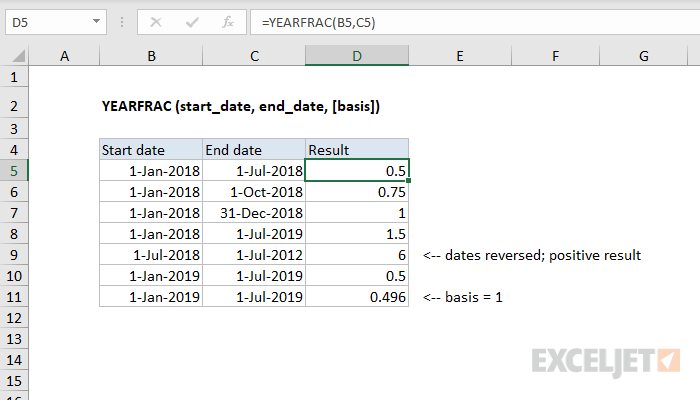Purpose
Return value
Syntax
=YEARFRAC(start_date,end_date,[basis])- start_date - The start date.
- end_date - The end date.
- basis - [optional] The type of day count basis to use (see below).
Using the YEARFRAC function
YEARFRAC returns a decimal number representing years between two dates. For example:
=YEARFRAC("1-Jan-2019","1-Jan-2020") // returns 1
=YEARFRAC("1-Jan-2019","1-Jul-2020") // returns 1.5
=YEARFRAC("1-Jan-2019","1-Jan-2021") // returns 2
Although the generic syntax for YEARFRAC shows the start date followed by the end date, you can provide the dates in any order with the same result. For example:
=YEARFRAC("1-Jan-2000","1-Jan-2019") // returns 19
=YEARFRAC("1-Jan-2019","1-Jan-2000") // returns 19
Basis options
YEARFRAC uses whole days between two dates to calculate the fraction of a year as a decimal number. The YEARFRAC function accepts an optional argument called "basis" that controls how days are counted when computing fractional years. The default behavior is to count days between two dates based on a 360-day year, where all 12 months are considered to have 30 days. The table below summarizes the available options:
| Basis | Calculation | Notes |
|---|---|---|
| 0 (default) | 30/360 | US convention |
| 1 | actual/actual | |
| 2 | actual/360 | |
| 3 | actual/365 | |
| 4 | 30/360 | European convention |
Note that basis 0 (the default) and basis 4 both operate based on a 360-day year, but they handle the last day of the month differently. With the US convention, when the start date is the last day of the month, it is set to the 30th day of the same month. When the end date is the last day of the month, and the start date < 30, the end date is set to the 1st of the next month, otherwise the end date is set to the 30th of the same month. With the European convention, start dates and end dates equal to the 31st of a month are set to the 30th of the same month.
Examples
With a start date in cell A1, and an end date in cell B1, the YEARFRAC will return years between the two dates as a decimal number:
=YEARFRAC(A1,B1) // years between two dates
To get a whole number only (not rounded), you can use the INT function like this:
=INT(YEARFRAC(A1,B1)) // whole number only, discard decimal
To get current age based on a birthdate, you can use a formula like this:
=INT(YEARFRAC(birthdate,TODAY())) // age from birthdate
Note: this formula can sometimes return incorrect results. See this example for more details.
To get the percentage of the current year complete, you can use YEARFRAC like this:
=YEARFRAC(DATE(YEAR(TODAY()),1,1),TODAY()) // % year complete

















